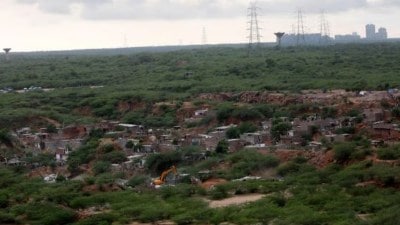Why a remote Kutch village could end up as a test bed for Mars mission
Researchers confirm the presence of jarosite, a yellow, iron-rich sulphate mineral, similar to what was discovered on Mars a couple of decades ago
 The jarosite deposit site in Matanomadh village, located nearly 100 km west of Bhuj in Gujarat. (Special Arrangement)
The jarosite deposit site in Matanomadh village, located nearly 100 km west of Bhuj in Gujarat. (Special Arrangement)Life in Matanomadh, a thinly populated village nearly 100 km west of Bhuj town in Gujarat’s Kutch district, has never been easy. Surrounded by thorny shrubs, the terrain is harsh and unforgiving, unfit for cultivation or large human settlements. Yet, this village might end up as a potential test bed for the Indian Space Research Organisation (ISRO) ahead of its Mangalyaan-2 mission to Mars.
A team of researchers from the Space Applications Centre (SAC) in Ahmedabad, the Savitribai Phule Pune University (SPPU) and the Birbal Sahni Institute of Palaeosciences in Lucknow recently confirmed that the age of jarosite – a mineral discovered in Matanomadh in 2016 – to be around 55 million years old, corresponding with the Paleocene period in the geological timeline.
 Jarosite is a yellow-coloured iron-rich sulphate mineral, similar to those discovered on Mars a couple of decades ago. (Special Arrangement)
Jarosite is a yellow-coloured iron-rich sulphate mineral, similar to those discovered on Mars a couple of decades ago. (Special Arrangement)
The dating of this mineral, found in a few rock structures in Matanomadh, suggests that there was a similar geological occurrence on both the planets millions of years ago. This, the researchers said, suggests that the conditions in the Kutch village resembled the environmental and chemical conditions thought to exist on Mars, and could offer an excellent test bed for the study of the red planet’s surface, mineralogy and biochemistry. The Matanomadh site could thus offer field-analogue missions for Mars, where rover motion, instrument testing, drilling, and geochemistry experiments could be performed. The findings were published in the Journal of the Geological Society of India last month.
“Our findings not only connect Earth’s geological past with Mars, but also provide a terrestrial ‘blueprint’ for astrobiology (study of life, its origins and evolution in planets and stars), mineral exploration and future space missions,” lead researcher Aditya Dharaiya, who was at Savitribai Phule Pune University’s Geology Department at the time of the study, told The Indian Express.
Incidentally, this is not the only site in India where researchers are trying to experience Mars-like conditions. ISRO has been trying to simulate the living conditions and environment of Mars and Moon in a desolate high-altitude village in Ladakh through its HOPE (Himalayan Outpost for Planetary Exploration) mission. In August, two crew members spent 10 days in a compact replica of a Mars habitat at Tso Kar Valley in Ladakh, about 4,500 metres above sea level, where the oxygen and air pressure are thin and temperatures are sub-zero. While the Ladakh site could offer a test bed for experiments on the environmental conditions of Mars, the Kutch village is expected to offer insights into the geology and mineral composition of Mars.
 What is jarosite
What is jarosite
It was in 2016 that a team led by the Space Applications Centre first reported the presence of jarosite in Kutch. Around the same time, its presence was confirmed along Kerala’s Varkala cliffs. But what makes Matanomadh better suited for Martian studies is its relative remoteness. In contrast, the site in Kerala, near the Varkala beach, is among the state’s most visited tourist locations.
Similar jarosite deposits have been found in Mexico, Canada, Japan, Spain, and in Utah and California in the US.
On Earth, jarosite is formed when some minerals rich in oxygen, iron, sulphur and potassium react in the presence of water. The discovery of jarosite on Mars was one of the strongest pieces of evidence of the presence of water on the planet at some point of time.
In 2004, NASA’s Opportunity mission to Mars was the first to detect traces of jarosite at the Meridiani Planum landing site. Subsequently, this mineral was detected at several other places on Mars, indicating its common occurrence on the red planet.
“On Earth, it is rare to find jarosite traces within sedimentary rocks. Jarosite formation is typically associated with volcanic activity. So, when volcanic activity dominated in Kutch millions of years ago, the volcanic ash (containing sulphur) may have mixed with the marine water, aiding the formation of jarosite,” Dharaiya said.
 Where is jarosite found in India?
Where is jarosite found in India?
The jarosite found in Matanomadh occurs as fine deposits mixed in clay. When mixed with water, this clay expands. Laboratory tests were later performed to sieve jarosite remains from this clay. The researchers found that this mix of sulphates and clays closely resembled those found on Mars.
As such, scientists believe that further studies on the jarosite samples of Matanomadh could help decode the palaeo-evolution of the Martian geology and the past chemical interactions on the planet. Moreover, as sulphates such as jarosite could trap organic molecules and elements that support life within them, examining these samples in Kutch could open a window of opportunity for designing strategies for future Mars missions that will explore life on the red planet.
Scientists hope their new findings will help to protect the Matanomadh site from natural and human threats. The site is currently waterlogged, and the presence of coal mines in the vicinity puts another layer of pressure on the rich and historic mineral deposits. Scientists said the site needed to be declared part of India’s significant planetary geo-heritage.



- 01
- 02
- 03
- 04
- 05




























